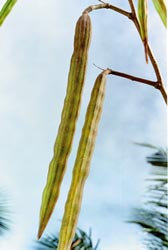Principle#4 – Natural Farming Means Nature does the Farming
Natural farming means nature does the farming and you take care not to allow anything unnatural to enter the farm
In practice, for us this principle translates into a simple rule: Do Not Interfere unnecessarily.
This means, beyond the initial design, abstaining from what is considered to be “normal” farming activities – tilling, weed elimination, cleaning unless we need that space for planting, pruning, using fertilizers and pesticides and flood irrigation. This doesn’t mean we have not or will not be doing anything at all. We need to do two things: 1) Minimize interference and 2) Observe and encourage the natural dynamics in the farm.
We need to take certain actions to minimize different types of interference from different sources: Trespassers who walk in with the intention of stealing, stray cattle that walk in to graze and make the soil really hard with their hoofs, marketers of fertilizers, pesticides and farm equipment, agriculture consultants and our own impatience and imaginary needs that might push us to do unnatural things.
To avoid trespassers and stray cattle, we planted a Live Fence. ‘Live’ doesn’t mean electricity but living plants and shrubs. Besides keeping away unwanted elements, it would also provide us biomass for mulching and for producing biogas, serve as wind breakers, provide timber for minor wood work, shade for saplings nearby and some medicines.
To handle marketers and consultants, we decided to make it obvious to whomever we spoke to that this farm is primarily for personal and community needs. We avoided participation in organic certification initiatives which currently is a tedious process done by farmers with the only motive of increasing the price of one’s produce.
To deal with our own impatience and imaginary needs, we are learning to accept inefficiencies and put the needs of the farm, cattle and community before our own needs (what is good for them is good for us).
In order to observe and encourage the natural dynamics of the farm, we try to walk around it almost every day. Once we finish our house construction and start living in the farm, we could do this regularly. There is no fixed objective for this walking around. During these walks, our job is to observe and respond. At the initial stages, we check for availability of water and mulching for a tree that was just planted, straighten a leaning sapling, plant new seeds and harvest whatever has grown on its own. As the farm evolves, there will be plenty of opportunities to nurture, play with and learn from the farm, the art of living.

